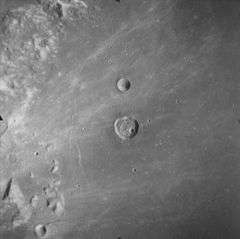Peirce (crater)
|
Apollo 17 mapping camera image | |
| Coordinates | 18°18′N 53°30′E / 18.3°N 53.5°ECoordinates: 18°18′N 53°30′E / 18.3°N 53.5°E |
|---|---|
| Diameter | 18 km |
| Depth | 1.8 km |
| Colongitude | 307° at sunrise |
| Eponym | Benjamin Peirce |

Peirce is a small lunar crater, named in honor of the mathematician Benjamin Peirce, which lies in the western part of Mare Crisium. That dark, circular lunar mare is located in the east-northeasterly part of the Moon's near side. Peirce lies to the north of the craters Yerkes and Picard, and southeast of Macrobius located outside the mare. Just over a crater diameter to the north (21-22 km) of Peirce is the smaller Swift. About 25 km west is a wrinkly ridge known as Dorsum Oppel.
The rim of Peirce is roughly circular, with a slight outward bulge along the northwestern rim. There are indications of slumping along the sides of this section, producing a wider inner wall. It is generally bowl-shaped, and is marked only by a tiny craterlet along the inner southeast rim. The interior is marked by several furrows, ridges, as well as a low, conical hill near the midpoint.
Satellite craters
By convention these features are identified on lunar maps by placing the letter on the side of the crater midpoint that is closest to Peirce.
| Peirce | Latitude | Longitude | Diameter |
|---|---|---|---|
| C | 18.8° N | 49.9° E | 19 km |
The following craters have been renamed by the IAU.
- Peirce B — See Swift (lunar crater).
References
- Andersson, L. E.; Whitaker, E. A. (1982). NASA Catalogue of Lunar Nomenclature. NASA RP-1097.
- Blue, Jennifer (July 25, 2007). "Gazetteer of Planetary Nomenclature". USGS. Retrieved 2007-08-05.
- Bussey, B.; Spudis, P. (2004). The Clementine Atlas of the Moon. New York: Cambridge University Press. ISBN 978-0-521-81528-4.
- Cocks, Elijah E.; Cocks, Josiah C. (1995). Who's Who on the Moon: A Biographical Dictionary of Lunar Nomenclature. Tudor Publishers. ISBN 978-0-936389-27-1.
- McDowell, Jonathan (July 15, 2007). "Lunar Nomenclature". Jonathan's Space Report. Retrieved 2007-10-24.
- Menzel, D. H.; Minnaert, M.; Levin, B.; Dollfus, A.; Bell, B. (1971). "Report on Lunar Nomenclature by the Working Group of Commission 17 of the IAU". Space Science Reviews. 12 (2): 136–186. Bibcode:1971SSRv...12..136M. doi:10.1007/BF00171763.
- Moore, Patrick (2001). On the Moon. Sterling Publishing Co. ISBN 978-0-304-35469-6.
- Price, Fred W. (1988). The Moon Observer's Handbook. Cambridge University Press. ISBN 978-0-521-33500-3.
- Rükl, Antonín (1990). Atlas of the Moon. Kalmbach Books. ISBN 978-0-913135-17-4.
- Webb, Rev. T. W. (1962). Celestial Objects for Common Telescopes (6th revised ed.). Dover. ISBN 978-0-486-20917-3.
- Whitaker, Ewen A. (1999). Mapping and Naming the Moon. Cambridge University Press. ISBN 978-0-521-62248-6.
- Wlasuk, Peter T. (2000). Observing the Moon. Springer. ISBN 978-1-85233-193-1.
External links
- LTO-44D4 Peirce — L&PI topographic map
- Peirce Crater: Apollo 17 vs. Lunar Orbiter 4 (accessed 10/04/05.)

